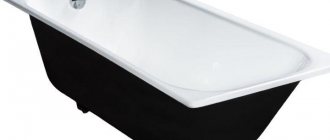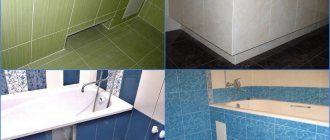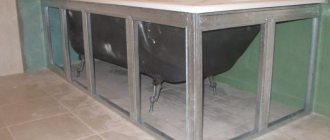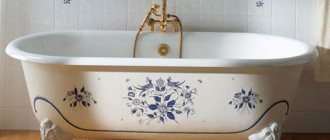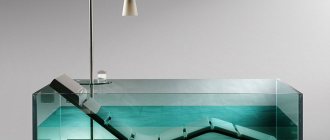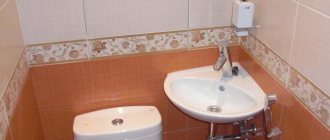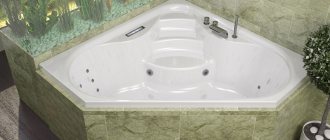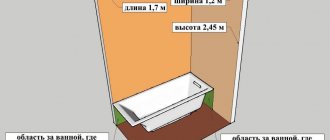Those who are renovating a bathroom, changing its design, are interested in information about what is the optimal height of the bathtub from the floor (the standard that exists today, does it allow changing the parameters) and how the installation of plumbing fixtures made of different materials differs.
Bathroom design.
Improper installation may result in equipment leaking, instability, falling or overturning.
What shapes do bathtubs come in?
Material is an important, but not always determining indicator when choosing a bathroom. No less attention is paid to the shape of the product: this largely depends on the parameters and dimensions of the room where the model will be installed. Plumbing manufacturers offer customers both traditional and non-standard bathtubs in various configurations.
- Rectangular. A classic version of the bathroom, known to us since Soviet times. Such universal models are suitable for any room. They are made from various materials and are usually mounted to the wall, but installation options in the center are possible. Sometimes they are sold with decorative panels that cover communications.
- Angular. A good solution for limited bathroom space. The advantages of this form are small size, space saving (they occupy one corner) and ease of installation. Corner models can be an isosceles triangle, rounded on one side, or an asymmetrical design with different side lengths, available in left and right versions. The dimensions of corner baths allow two people to take a bath. In addition, they are usually equipped with additional options - hydromassage, air massage system, chromotherapy, which makes the procedures as comfortable as possible.
- Oval. Popular since antiquity. Ergonomic shape and elegant appearance are their main advantages. Such models are installed on thin forged legs or a pedestal, against the wall.
- Round. These bathtubs decorate the interior, they are comfortable and safe. They can be mounted in the middle of the room, against a wall or in a corner, or built into the floor. However, this option is applicable only in large bathtubs due to their volumetric dimensions.
- Non-standard baths. These are various design delights that cannot be attributed to any of the usual types: polygonal and other free forms. The purchase and installation of such models is usually planned together with an interior designer.
Important!
Before buying a bathtub, do not forget to measure the door opening: if the model is wider, installation will be difficult.
How to choose the right bath size
When planning to install a bathtub, you need to decide not only on the shape, but also on the size: you should be comfortable not only taking water procedures, but also being in the room. The standard parameters of classic bathtubs vary from 120 cm in length to 170. Height - 50-65, width - from 70 to 85 cm. In addition, it is necessary to take into account the dependence of the parameters of the models on the shape.
- Corner baths with average sizes from 120x120 cm to 180x180 cm (standard) and 120x60 cm to 190x170 cm (asymmetric).
- Standards for oval bathtubs are from 140 to 210 cm in length. Such products can be installed in small spaces.
- Round models with parameters from 140 cm to 170 are installed in bathrooms of non-standard sizes, where free access is assumed from all sides.
When choosing, the needs and preferences of family members are taken into account. For example, for older people a sitz bath with a depth of 70-80 cm will be comfortable, and for children it is comfortable in smaller but more spacious models. A bathtub width of 70-80 cm is optimal for people of average build.
How to choose a bathtub for a small bathroom
Choosing a bathroom model for a spacious room is not difficult: a large area allows you to realize all the owner’s ideas. But what if the bathroom is located on a tiny spot? Don’t deprive yourself of the pleasure of soaking in relaxing foam after work: you can install a bathtub in a small room. You just need to understand what characteristics a model placed in the bathroom should have.
Maximum comfort with minimal dimensions are the main indicators of a small bathtub. Several types of models have these advantages.
- Asymmetrical. Oval, drop-shaped, heart-shaped bathtubs of non-standard shapes can have very compact sizes, from 90x90 cm. The best option is a product with a length of 120-130, in such a container you can take procedures without much inconvenience.
- Angular. Ideal for a small bathroom. You can choose a model with dimensions starting from 90 cm in length, there are options for right- and left-hand installation.
- Sedentary. These models are chosen if you need to save as much space as possible in order to place, for example, a washing machine or a cabinet under the sink. Sedentary models can be round, oval, or have the shape of a rounded triangle. The length of the products is no more than a meter. The best option is sit-down corner mini-baths: their range is constantly expanding by the manufacturer.
On a note.
Sitz baths are beneficial not only because they save usable space - they significantly reduce the water consumption for procedures.
Dimensions of plumbing cabins
The dimensions of the plumbing cabins are especially interesting. There is a gap between the cabin and the base walls of the apartment. There is a particularly large distance between the cabin ceiling and the apartment ceiling. For this reason, a type of bathroom renovation has emerged, which is more often called combining a bathroom with demolishing a plumbing cabin.
The dimensions of standard plumbing cabins are as follows (GOST 18048-80): L×W×H
- 2730×1600×2400(2540,2640,2740)
- 2080×1820×2400(2540,2640,2740)
- 1100×1600×2400(2540,2640,2740)
- 940×1600×2400(2540,2640,2740)
Baths with additional systems
For the convenience and comfort of the person receiving water procedures, some types of baths are equipped with additional options. Such models are called hydromassage and can include various systems.
- Hydromassage is the impact of water jets on certain areas of the body. Depending on the size of the bathtub, 5-6 nozzles are built into the wall of the bathroom, from which water is supplied, driven by a pumping system. Thanks to this, the elimination of toxins is accelerated, metabolism and overall well-being are improved.
- Aeromassage. A system consisting of 8-16 nozzles located at the bottom of the bath and a compressor supplying hot air. When hot air enters the water under pressure, it creates foam and gently massages the body. Promotes relaxation of the body, usually used in conjunction with hydromassage and chromotherapy.
- Turbo massage. Combination of aero- and hydromassage. This feature makes it possible to turn on both systems simultaneously or use them alternately, as well as adjust the intensity of the massage.
- Chromotherapy is the effect of light on the psycho-emotional and general physical state. The jets have a built-in electronic color waterproof device that changes the flow and shades of light. It refreshes, calms, has a relaxing effect, and creates a certain mood. Each color has a specific effect on the emotional sphere and organ functions.
- Ozonation. Saturation of water with oxygen, its purification, destruction of pathogenic bacteria. Ozone is supplied through the jets along with water.
- Disinfection. After the bathing process, a disinfectant is supplied to a special tank, then the purification system is turned on.
- Electronic control of all functions. There are models equipped with a remote control.
Hydromassage baths are created in such a way that water and air act on the back, lower back, pelvic and collar areas, calves, and feet. There are models that make it possible to receive massage from all sides.
You can purchase a ready-made hot tub, or you can equip an already purchased model with options. Typically, additional systems are built into acrylic bathtubs: they are more convenient and easier to install and maintain than models made from other materials. Installation on a cast iron bath is possible, but this is technologically difficult and expensive. But it is not recommended to install additional functionality on steel models: they are already too “noisy”, and thin walls will make sound vibrations from the operation of the equipment even stronger.
Important!
To install additional systems, it is necessary that the thickness of the bathtub wall be at least 4 mm!
Tips for choosing a bath
Everyone selects a bathtub model based on their own considerations. Some people focus on efficiency, others value comfort, and some want to outdo their neighbors and buy the largest and most expensive model. In any case, the bathtub must meet the main criteria: be comfortable in shape and size, durable, safe and, preferably, serve as long as possible without causing trouble to the owner. Let a few general recommendations help you make the best choice.
- The size and shape of the bathtub must be selected to suit the parameters of a particular room, taking into account the location of drainage and sewer lines.
- The siphon and other elements must come with the bathtub - otherwise you need to purchase them together with the bowl, checking for compatibility. It is better if the components are manufactured by the same company that makes the hot tub.
- Pay attention to safety, especially when it comes to children or the elderly: choose bathtubs with anti-slip coating and equipped with handles.
- Before purchasing, you should carefully check the bowl for chips and microcracks outside and inside.
- High-quality acrylic of a single color, without yellowness or unpleasant odor, wall thickness - from 4 mm.
- The drain hole should be located below the bottom level: then the water will not stagnate.
And one last piece of sensible advice.
If you have the financial means, consider types of bathtubs from well-known manufacturers: this will reduce the risk of purchasing a low-quality or defective product.
You can leave your review of the article here.
Stages and difficulties of installing bathtubs
The first thing you need to do when starting to install a bathtub is to consult with a specialist in this field. High-quality installation depends on many factors and strictly phased implementation of installation work. Different models have their own installation nuances, but there are general recommendations that need to be taken into account when getting started.
- Preparing the base. It must be perfectly level so that the bath takes a strictly horizontal position in level. Violation will lead to stagnation of water in the pipe.
- Installation of the frame or legs on the font, depending on the design and material of the bathroom. The legs must be screwed on carefully so as not to damage the structure.
- Bathtub fixing. There are special hooks on the font for connection to the wall, and the legs are attached to the floor with self-tapping screws.
Attention!
Fixing the legs to the floor for the safety of the structure is carried out using self-tapping screws - many craftsmen ignore this point!
- Sealing all joints and crevices using silicone sealant or special tape.
- Assembling the siphon and connecting the structure to the sewerage system.
- Checking the tightness of connections. To do this, fill the font with water up to half, which can be left for another day so that the structure shrinks.
- Installation of a decorative screen, which is included in the kit or made independently. The main conditions are that the materials must be resistant to moisture, the formation of fungus and mold, the panel must be installed in such a way as to easily provide access to communications if necessary.
Each type of bathtub has its own characteristics that must be taken into account in order to avoid installation difficulties.
- Cast iron. It is better to avoid installing it on legs (this is too weak a mount for a heavy bathtub); install cast iron bathtubs on brickwork. And one more piece of advice: cast iron models are not attached to the wall: before “building” such a bathtub into the wall (as many people like to do), think that dismantling it, if desired, will only be possible after a major renovation of the bathroom.
- Acrylic. When attaching the legs to the bathtub, you should use the self-tapping screws only from the kit, in no case longer than necessary: if the screw damages the acrylic layer, even slightly, the bathtub can be thrown away. And one more thing: if the person who will use the acrylic bathtub weighs a lot, it is better to install the font on a brick cushion. The gap between the pillow and the bathtub must be at least 10 cm - for sealing with polyurethane foam.
Advice.
It is impossible to install a cast iron bathtub yourself: it is too bulky and heavy. Get a helper!
And the main advice
: if you have doubts that you can handle it, contact an installation specialist who will guarantee the quality of the work - this will save you from worrying about the installation and provide confidence that any shortcomings will be eliminated.
Main types of breakdowns
Plastic components have good temperature tolerance, but it is not recommended to take water at temperatures higher than 95 degrees. Using boiling water will cause the material to deform.
Acrylic bathtubs have poor protection against impacts and other mechanical damage. A crack will form even if you drop a light object into the container.
Often breakdowns occur due to a discrepancy between a person’s weight and the maximum design capabilities. Well-known manufacturers provide users with an additional frame made of high-strength metal.
Questions and answers from our customers
Question.
What should you pay attention to first when buying a bathtub?
Answer.
Look at the integrity of the enamel, corners and drainage area. Also, if possible, climb into the bathtub - it should not sag under your weight.
Question.
I heard/heard that the warranty is lost by any little thing. What needs to be done to avoid losing the warranty on the bathtub?
Answer.
To maintain the warranty on your bathtub, you need to do everything according to the instructions.
Question.
A sewerage system will be installed under the bathtub. What points should you pay attention to?
Answer.
On whether the bias will be observed. First, you need to look at the place where the sewer intake pipe will come from and determine its height from the floor level. Secondly, it is important to determine the length of the pipe that will connect the sewer and siphon.
Combined bathroom
Even a small queue of household members may form in front of such bathrooms in the morning, so it is necessary to properly think through the arrangement in order to save time.
But it is important to consider that there must be a distance of at least 0.7 m from the bathtub bowl to the toilet; this parameter complies with the rules and regulations of personal hygiene and sanitation.
